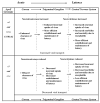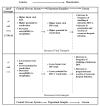Apolipoprotein E alleles can contribute to the pathogenesis of numerous clinical conditions including HSV-1 corneal disease
- PMID: 17007837
- PMCID: PMC2217677
- DOI: 10.1016/j.exer.2006.08.001
Apolipoprotein E alleles can contribute to the pathogenesis of numerous clinical conditions including HSV-1 corneal disease
Abstract
Apolipoprotein E (ApoE) alleles have been reported to affect the clinical outcome of numerous cardiovascular, neurodegenerative, and viral infectious diseases, including atherosclerosis, Alzheimer's disease (AD), hepatitis C, and HIV. The major alleles of ApoE are 2, 3, and 4. ApoE genotypes have been hypothesized to regulate many biological functions, resulting in significant changes in the onset and/or outcome (severity and duration) of several clinical conditions. Based on genetic analyses in human and animal studies using knockout (ApoE -/-) mice and mice transgenic for human 3 and 4, we present evidence that strongly suggests that the ApoE alleles can regulate the pathogenesis of ocular herpes simplex virus type 1 (HSV-1) infections. This review will summarize the major studies that support this hypothesis. Significant gender based differences in HSV-1 pathogenesis have also been reported, suggesting that hormonal regulation combined with ApoE genotype plays a significant role in HSV-1 pathogenesis. Identification of specific mechanisms in ocular HSV-1 infections related to the ApoE alleles and gender could lead to therapeutic intervention based on the properties of the apoE isoforms. While many clinical investigations have been reported and, to a lesser extent, transgenic mouse studies have been conducted, no specific mechanisms of how ApoE induces or alters clinical disease are known.
Figures
Similar articles
-
Effect of human apolipoprotein E genotype on the pathogenesis of experimental ocular HSV-1.Exp Eye Res. 2008 Aug;87(2):122-30. doi: 10.1016/j.exer.2008.05.007. Epub 2008 May 18. Exp Eye Res. 2008. PMID: 18572164 Free PMC article.
-
Apolipoprotein E genotype influences vertical transmission of herpes simplex virus type 1 in a gender specific manner.Aging Cell. 2007 Dec;6(6):841-2. doi: 10.1111/j.1474-9726.2007.00332.x. Epub 2007 Aug 24. Aging Cell. 2007. PMID: 17725689
-
Apolipoprotein E and herpes virus diseases: herpes simplex keratitis.Eur J Hum Genet. 1999 Apr;7(3):401-3. doi: 10.1038/sj.ejhg.5200313. Eur J Hum Genet. 1999. PMID: 10234519
-
Apolipoprotein E as a Therapeutic Target in Alzheimer's Disease: A Review of Basic Research and Clinical Evidence.CNS Drugs. 2016 Sep;30(9):773-89. doi: 10.1007/s40263-016-0361-4. CNS Drugs. 2016. PMID: 27328687 Free PMC article. Review.
-
The role of apolipoprotein E in Alzheimer's disease: pharmacogenomic target selection.Biochim Biophys Acta. 2000 Jul 26;1502(1):85-94. doi: 10.1016/s0925-4439(00)00035-1. Biochim Biophys Acta. 2000. PMID: 10899434 Review.
Cited by
-
Some evolutionary perspectives on Alzheimer's disease pathogenesis and pathology.Alzheimers Dement. 2012 Jul;8(4):343-51. doi: 10.1016/j.jalz.2011.05.2408. Epub 2011 Dec 3. Alzheimers Dement. 2012. PMID: 22137143 Free PMC article. Review.
-
Disease parameters following ocular herpes simplex virus type 1 infection are similar in male and female BALB/C mice.PLoS One. 2023 Jun 15;18(6):e0287194. doi: 10.1371/journal.pone.0287194. eCollection 2023. PLoS One. 2023. PMID: 37319284 Free PMC article.
-
Search for age-related macular degeneration risk variants in Alzheimer disease genes and pathways.Neurobiol Aging. 2014 Jun;35(6):1510.e7-18. doi: 10.1016/j.neurobiolaging.2013.12.007. Epub 2013 Dec 19. Neurobiol Aging. 2014. PMID: 24439028 Free PMC article.
-
Human brain changes across the life span: a review of 56 longitudinal magnetic resonance imaging studies.Hum Brain Mapp. 2012 Aug;33(8):1987-2002. doi: 10.1002/hbm.21334. Epub 2011 Sep 13. Hum Brain Mapp. 2012. PMID: 21915942 Free PMC article. Review.
-
Intracerebral propagation of Alzheimer's disease: strengthening evidence of a herpes simplex virus etiology.Alzheimers Dement. 2013 Mar;9(2):169-75. doi: 10.1016/j.jalz.2012.07.005. Epub 2012 Nov 14. Alzheimers Dement. 2013. PMID: 23159044 Free PMC article. Review.
References
-
- Alber DG, Powell KL, Vallance P, Goodwin DA, Grahame-Clarke C. Herpes virus infection accelerates atherosclerosis in the apolipoprotein E-deficient mouse. Circulation. 2000;102:779–785. - PubMed
-
- Baird PN, Guida E, Chu DT, Vu HT, Guymer RH. The e2 and e3 alleles of the apolipoprotein gene are associated with age-related macular degeneration. Invest Ophthalmol Vis Sci. 2004;45:1311–1315. - PubMed
-
- Ball MJ, Matthews R, Steiner I, Hill JM, Wisner TW, Murdoch GH, Kohama S, Sexton G, Nagalla S. Latent HSV-1 virus in trigeminal ganglia: the optimal site for linking prevention of Alzheimer's disease to vaccination. Neurobiol Aging. 2001;22:705–709. - PubMed
-
- Ball MJ, Nuttall K, Warren KG. Neuronal and lymphocytic populations in human trigeminal ganglia: implications for ageing and for latent virus. Neuropathol Appl Neurobiol. 1982;8:177–187. - PubMed
-
- Baringer JR, Pisani P. Herpes simplex virus genomes in human nervous system tissue analyzed by polymerase chain reaction. Ann Neurol. 1994;36:823–829. - PubMed
Publication types
MeSH terms
Substances
Grants and funding
LinkOut - more resources
Full Text Sources
Medical
Miscellaneous



